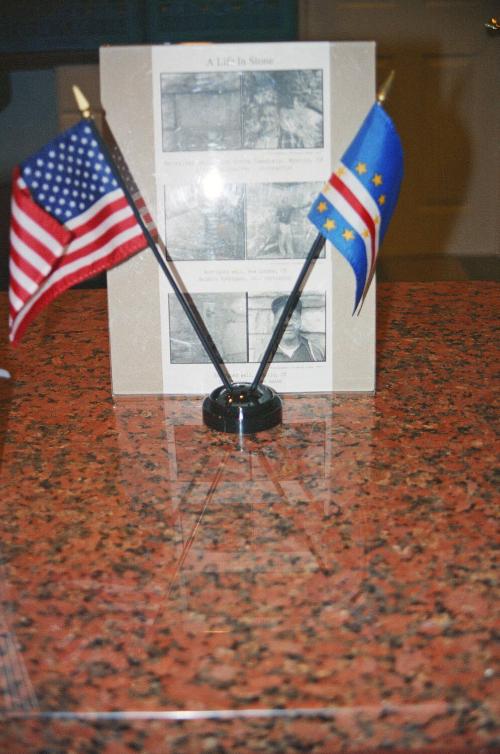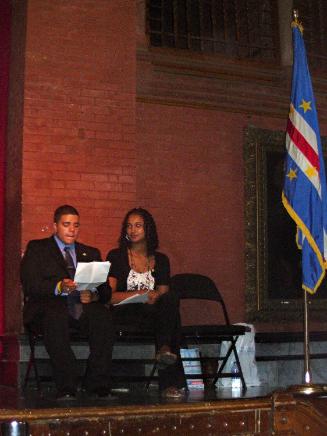Exhibition Opening - A Life in Stone: The Cape Verdean Stonemasonry Tradition in Eastern Connecticut
SubjectPortrait of
Alfred Gonsalves
(Cape Verdean)
SubjectPortrait of
Roberta Delgado Vincent
(Cape Verdean)
SubjectPortrait of
Elanah Sherman
SubjectPortrait of
José Santos
(Cape Verdean)
PhotographerPhotographed by
Richmond Jones
PhotographerPhotographed by
Peter Crowley
PhotographerPhotographed by
Lynne Williamson
Date2008 January 4
Mediumborn digital images
ClassificationsGraphics
Credit LineConnecticut Cultural Heritage Arts Program collections
CopyrightCopyright Held By Lynne Williamson; Copyright Held By Richmond Jones
Object number2015.196.386.1-.11
DescriptionPhotographs from the "A Life in Stone: The Cape Verdean Stonemasonry Tradition in Eastern Connecticut" exhibition opening in 2008.
2015.196.386.1: Image showing American and Cape Verdean flags in front of historical photos at the exhibit opening.
2015.196.386.2-.3: Images showing people at exhibit inside the Norwich Arts Council’s NAC Gallery.
2015.196.386.4: Image showing gallery visitors, students from Norwich Free Academy, with artwork visible in background.
2015.196.386.5: Image showing exhibit photographers Peter Crowley and Richmond Jones.
2015.196.386.6-.7: Images showing display of partial stone wall and tools, created by Alfred Gonsalves, with gallery visitors in background.
2015.196.386.8: Image showing Alfred Gonsalves and Roberta DelGado Vincent standing beside a photo portrait of stonemason Jose Santos.
2015.196.386.9: Image showing exhibit collaborators (left to right) Elanah Sherman, Belmiro Rodrigues, Alfred Gonsalves, and Jose Santos.
2015.196.386.10: Image showing Jose Santos, stone mason; photo by Peter Crowley.
2015.196.386.11: Image showing Rodrigues’ wall in Niantic, Connecticut; photo by Richmond Jones.
NotesSubject Note: "A Life in Stone: The Cape Verdean Stonemasonry Tradition in Eastern Connecticut" documented a little-known but vibrant occupation practiced by generations of Cape Verdean stonemasons in the Norwich, Connecticut area. The exhibit displayed twenty-eight black and white photographs of masons and their work taken by two photographers, Peter J. Crowley of Norwich and Richmond Jones of South Britain. After its opening in the Norwich Art Center in January 2008, the exhibit traveled to Hartford where the exhibit was on view at the Jean J. Schensul Community Gallery at the Institute for Community Research from April 4 to June 14, 2008. Norwich Cape Verdean stonemason Alfred Gonsalves built a portion of a stone wall in the gallery. Gonsalves along with fellow stonemasons Belmiro Rodrigues and José Santos discussed their work at the exhibit opening event. Exhibit photographs were available for purchase.2015.196.386.1: Image showing American and Cape Verdean flags in front of historical photos at the exhibit opening.
2015.196.386.2-.3: Images showing people at exhibit inside the Norwich Arts Council’s NAC Gallery.
2015.196.386.4: Image showing gallery visitors, students from Norwich Free Academy, with artwork visible in background.
2015.196.386.5: Image showing exhibit photographers Peter Crowley and Richmond Jones.
2015.196.386.6-.7: Images showing display of partial stone wall and tools, created by Alfred Gonsalves, with gallery visitors in background.
2015.196.386.8: Image showing Alfred Gonsalves and Roberta DelGado Vincent standing beside a photo portrait of stonemason Jose Santos.
2015.196.386.9: Image showing exhibit collaborators (left to right) Elanah Sherman, Belmiro Rodrigues, Alfred Gonsalves, and Jose Santos.
2015.196.386.10: Image showing Jose Santos, stone mason; photo by Peter Crowley.
2015.196.386.11: Image showing Rodrigues’ wall in Niantic, Connecticut; photo by Richmond Jones.
"A Life in Stone" was developed by the Norwich Cultural Arts and History Project, a community-based initiative devoted to exploring the lives and contributions of cultural groups who have extraordinary stories to tell about their heritage. The project was a sponsored affiliate of the Norwich Arts Council. Exhibit curator and Project coordinator Elanah Sherman commented that “The Cape Verdean stone masonry tradition is not only interesting in itself but also acts as a window that, once opened, provides an expansive view of an entire cultural group."
Retired whalers, stone masons, and builders from the islands of Fogo, Brava, and Sao Nicolau settled in Norwich in the late 19th and early 20th century. Census records show that many of these immigrants lived in neighborhoods close to the Norwich harbor and were employed as coal shovelers for railroad and steamship companies as well as continuing their original occupations. Stonemasonry was an important traditional occupation, and the three masons featured in the exhibit represent a line of fathers and sons working in stone. Along with the Catholic Church, the Cape Verdean community was traditionally bound together by the Santiago Society, a social organization caring for the culture and welfare of local Cape Verdeans. Members of the Santiago Society assisted in the development of the exhibit. The exhibit opening on April 4 included a presentation on Cape Verdean history, language, and dance by students from Norwich Free Academy; a wine tasting offered by a Cape Verdean vintner; and Cape Verdean food.
The Connecticut Cultural Heritage Arts Program collaborated with Cape Verdeans across the state from 1997 for many years, producing a book on Cape Verdean community histories and sponsoring apprenticeships between master artists and students of traditional music. This community-based work resulted in an archive of oral histories, music, and research on Connecticut Cape Verdeans that is now part of the CCHAP archive.
Subject Note for Norwich Cape Verdean Community: The Cape Verdean Santiago Society Inc., a Norwich-based social and cultural organization incorporated on June 6, 1939, was housed in a building at 84 Talman Street in the heart of the Norwich Cape Verdean community. Norwich today is home to more than 1,500 Cape Verdeans, descendants of immigrants from the Cape Verde Islands off the west coast of Africa as well as newcomers from the islands. The population continues to grow as Cape Verdean-Americans save money to bring their families from the islands in order to provide a prosperous life for them in America. Many older Cape Verdeans and the new arrivals speak the language Krioulu, a blend of African and Portuguese dialects. Norwich Free Academy has several Cape Verdean students attending.
Retired whalers, stone masons, and builders from the islands of Fogo, Brava, and Sao Nicolau settled in Norwich in the late 19th and early 20th century. Census records show that many of these immigrants lived in neighborhoods close to the Norwich harbor and were employed as coal shovelers for railroad and steamship companies as well as continuing their original occupations.
The main Cape Verdean neighborhood in Norwich developed on the hilly east side, along Talman Street, anchored by the social club, and continued through the Laurel Hill area to Sunnyside Avenue. The close-knit community maintained traditional ties of kinship and reciprocity. The Santiago Society long served as a focal point for the community, offering social and economic assistance. Named after the island of Santiago, whose city Praia is the capital of Cape Verde, the Norwich Society developed out of the local branch of a mutual aid association in Providence. In 1939, the Santiago Society established the social club on Talman Street and organized activities every weekend, providing a place of contact where new arrivals could mix with other Cape Verdeans, giving them a sense of belonging to a community and helping to ease their homesickness. The social club also hosted wedding receptions, baby showers, fund raising events, and other celebrations. Members would engage in the traditional games of bisca and ouril and share stories. A deeply religious group, Cape Verdeans often held traditional wakes at the Club. Women would chant the choroguiza, crying and talking about the deceased in communal mourning. Afterwards members distributed food to the bereaved family. Generations of Norwich Cape Verdeans made the Club the heart of their community, but unfortunately the Club burned down on January 23, 2007, and has disbanded.
Cape Verdeans everywhere have a gift for music, and in Norwich there have been two popular bands playing Cape Verdean and American styles of music: the Santos Brothers Band and the Delgado band. Descendants of these families still live in the area today. Two Cape Verdean families in Norwich produced popular bands. The Santos Brothers - Abel, Matthew, Antonio Sr., and José, along with their sister Lena on vocals - played Cape Verdean dance music on the radio in Norwich in 1947 and at clubs and dances all over New England until the mid-1970s. When their parents hosted kitchen dances, the brothers watched the grownups to learn how to play the viola, mandolin, and guitar. They have passed their musical ability onto the next generation - Antonio Sr. has formed a band, The Santos Family Band, with son Antonio Jr. and daughters Wendy, Leona, and Lisa. They were inspired by the Delgados, a well-known quartet (later a sextet) who played Krioulo music together as boys starting in the late 1920s. (Some members of the Delgado family spell the name differently). Later with their sister Mary as singer, the group performed jazz, ragtime, and popular tunes at speakeasies and clubs, appearing with Cab Calloway and Louis Armstrong, among other jazz greats.
Several Cape Verdean leaders have visited Norwich: General Consul Maria de Jesus Mascarenhas and Cape Verde Ambassador José Brito attended a celebration of the reconstruction of St. Anthony's Chapel held at the American Legion in Norwich on October 30, 2005. Cape Verde Prime Minister José Maria Pereira Neves and his delegation visited Norwich in 2007; a special reception in his honor was held by the community.
Starting in 2021, a team of Norwich Cape Verdeans and researchers have conducted a project with historian Rachel Carley to compile a detailed community history to research, document, and make accessible the rich history of Cape Verdeans who have settled in the Norwich area and who continue to be an important part of the community today. This project will also highlight the built environment that helped to shape Cape Verdean life in Norwich. For many members of ethnic communities, their traditions have deep roots in history and culture, and are an important source of cultural identity and knowledge. Former Santiago Society Board member Alfred H. Gonsalves states, “If our history is not documented, it will be lost forever. One of our main project activities will be to interview older Cape Verdeans who have a wonderful store of memories and knowledge, so that we can gather this information and pass it on to our young people.”
Biographical Note: Alfred (Freddie) Gonsalves, José Santos, and Belmiro (Junie) Rodrigues, Cape Verdean stonemasons, are members of three Cape Verdean families that have worked in this occupation for several generations in the Norwich area. They learned from their fathers in the course of working on masonry since their teens and have built successful businesses in southeastern Connecticut while serving important roles in the Cape Verdean community, most notably as president and past president of the Santiago Society, an active Cape Verdean cultural organization. Freddie designed and oversaw the reconstruction of St. Anthony’s Chapel, rescuing and re-siting this historic Norwich Cape Verdean landmark when it was threatened with demolition in 2004. Freddie won a Connecticut Historic Preservation award for this work in 2008, and has also received a Cape Verdean Hall of Fame award. Belmiro assisted the Cape Verdean youth dance group Estrellas directed by Angelina Santos, when they apprenticed to musician Joao Monteiro in 2005 under the Southern New England Traditional Arts Apprenticeship Program. José Santos and his brothers were members of the popular Cape Verdean music group The Santos Brothers.
Additional materials exist in the CCHAP archive
Cataloging Note: This project was made possible in part by the Institute of Museum and Library Services MA-245929-OMS-20.
Status
Not on viewGeneral Consul Maria de Jesus
2005 October - November
Alfred Gonsalves
2008 April-June
Alfred Gonsalves
2005 September 17
























